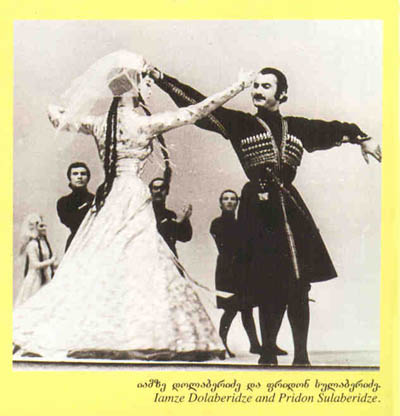
"All the ills of mankind, all the tragic misfortunes that fill the history books, all the political blunders, all the failures of the great leaders have arisen merely from a lack of skill at dancing" said Moliere once.
Havelock Ellis remarked that "Dancing is the loftiest, most moving, the most beautiful of the arts, because it is no mere translation or abstraction from life: IT IS LIFE ITSELF!"
Still others believe that "Any problem in the world can be solved by dancing." This may sound a little overbearing, but I am certain that dancing brings happiness and peace to the soul for at least the longevity of the performance. Why? Because, it is "the only art form where the artist is also the medium of expression."
You may wonder why do I make such strong statements about dancing. It is because I had dedicated half of my life to Georgian Folk dancing. For me, dancing was not just another extracurricular activity. It was my life. I strongly believed that I was born to dance. Unfortunately, life took me away from a dancing career. However, the love of dancing, especially Georgian Folk Dancing, still remains in my heart.
Now, without much more ado, I would like to introduce to you the art of Georgian Folk dancing. These breathtaking and absolutely awesome dances represent a live history book expressing the centuries of Georgian art, culture, and tradition. Georgian Folk dances are not very famous around the world, but their magnificence and the beauty cannot be forgotten by anyone who sees it. Many times have Georgian dance groups, whether professional or amateur, mesmerized the world with the beauty. The beautiful costumes blend history and art in one single harmony. This, coupled with at times rough and technical movements, leaves the audience in total awe. Georgian Folk dances give immense pleasure to not only the audience, but to the dancers also. As a former dancer, I can say that every time I danced, I felt as free as a bird. At those moments, I knew that dancing could save the world.
Before we go into a detailed description of each dance, let me give you a general overview of the dances. Each dance portrays the life of the region in which it originated, and thus is diverse and unique. The mountain dances, such as Khevsuruli, Kazbeguri, or Mtiuluri, are sharply different from some valley dances—i.g. Acharuli and Davluri. The costumes are different for every dance and resemble the clothing of the past in different regions of Georgia. The costumes worn today for Georgian dances have been designed and perfected by Simon Virsaladze. Furthermore, the choreographic structure of many dances has been modified to fit the stage performance. Most of the modifications were born out of the choreographic genius of Nino Ramishvili and Iliko Sukhishvili (the founders of the Georgian State Dance Company).
To view each dance individually, please click on the name of the dance, or simply scroll down the window.
| Acharuli | Khonga |
| Khorumi | Simdi |
| Partsa | Karachokheli |
| Kazbeguri | Kintouri |
| Khandjluri | Davluri |
| Khevsuruli | Samaia |
| Mtiuluri | Jeirani |
![]()
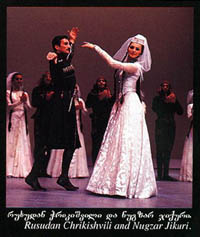 |
Kartuli
- The dance Kartuli many times reminds the audience of a wedding . Kartuli is a truly
romantic dance. It is performed by a dance couple and incorporates the softness and
gracefulness of a woman and dignity and love of a man. It shows that even in love, men
uphold their respect and manners by not touching the woman and maintaining a certain
distance from her. The man’s eyes are always focused on his woman partner as if she
was the only being in the whole world. Furthermore, at all times, man’s upper body
stays motionless. On the other hand, the woman keeps her eyes downcast at all times and
glides on the rough floor as a swan on the smooth surface of a lake. The utmost skill,
which is necessary to perform Kartuli, has earned the dance a reputation of one of the
most difficult dances. There were only a few great performers of Kartuli. Some of these
are Nino Ramishvili and Iliko Sukhishvili, and Iamze Dolaberidze and Pridon Sulaberidze.
|
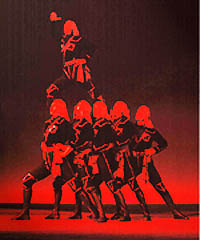 |
Khorumi – This war dance has originated in the region of Achara, which is located in the southwestern region of Georgia. The dance was originally performed by only a few man. However, over time it has grown in scale. In today’s version of Khorumi, thirty or forty dancers can participate. Although the number of performers changed, the content of the dance is still the same. The dance brings to life Georgian army of the past centuries. A few men who are searching the area for a campsite and enemy camps perform the initial "prelude" to the dance. Afterwards, they call the army onto the battlefield. The exit of the army is quite breathtaking. Its strength, simple but distinctive movements and the exactness of lines create a sense of awe on stage. The dance incorporates in itself the themes of search, war, and the celebration of victory as well as courage and glory of Georgian soldiers. Since Georgia has seen many wars throughout its history, Khorumi is a call from the past and reminds us that in order to have peace, we must have war. |
Acharuli – Acharuli has also originated in the region of Achara. It is where the dance gets its name from. Acharuli is distinguished from other dances with its colorful costumes and the playful mood that simple but definite movements of both men and women create on stage. The dance is characterized with graceful, soft, and playful flirtation between the males and females. Unlike Kartuli, the relationship between men and women in this dance is more informal and lighthearted. Acharuli instills the sense of happiness in both the dancer and the audience. |
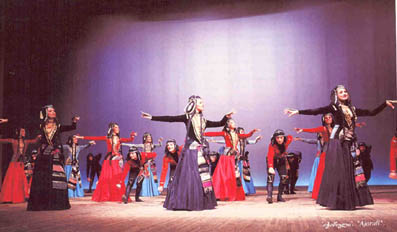 |
|
|
Partsa – Partsa has its origins in Guria (another region in Georgia) and is characterized by its fast pace, rhythm, festive mood, and colorfulness. As a performer, I can say that during a partsa performance, a dancer feels like a bird in the sky, flying across the stage barely touching the floor. Partsa mesmerizes the audience with not only speed and gracefulness, but also with "live towers." This dance creates a mood and a desire to party. |
|
Khanjluri – Historically, Georgians tend to strive for excellence. This trend is portrayed in our folk dances. Thus, many Georgian dances are based on the idea of competition. Khanjluri is one of those dances. In this dance, shepherds, dressed in red chokhas (traditional men’s wear) compete with each other in the usage of daggers and in performing complicated movements. One performer replaces another, and the courage and skill overflows on stage. Since Khanjluri involves daggers and knives, it requires tremendous skill and practice on the part of the performers. |
Khevsuruli – This mountain dance is probably the best representative of the Georgian spirit. It unites love, courage, and respect for women, toughness, competition, skill, beauty, and colorfulness into one amazing performance. The dance starts out with a flirting couple. Unexpectedly, another young men appears, also seeking the hand of the woman. A conflict breaks out and soon turns into a vigorous fighting between the two men and their supporters. The quarrel is stopped temporarily by the woman’s veil. Traditionally, when a woman throws her head veil between two men, all disagreements and fighting halts. However, as soon as the woman leaves the scene, the fighting continues even more vigorously. The young men from both sides attack each other with swords and shields. In some occasions, one man has to fight off three attackers. At the end, a woman (or women) comes in and stops the fighting with her veil once again. However, the final of the dance is "open" –meaning that the audience does not know the outcome of the fighting. As a characteristic of Georgian dances, Khevsuruli is also very technical and requires intense practice and utmost skill in order to perform the dance without hurting anyone.
|
|
Mtiuluri – Mtiuluri is also a mountain dance. Similar to Khevsuruli, Mtiuluri is also based on competition. However, in this dance, the competition is mainly between two groups of young men. It is more like a celebration of skill and art. At first, groups compete in performing complicated movements. Then, we see girl’s dance, which is followed by individual dancer's performance of amazing "tricks" on their knees and toes. At the end, everyone dances a beautiful final. This dance truly reminds us of a festival in the mountains. |
Khonga and Simdi – Both of these dances have their roots in Osetia – a region in Northern Georgia. They have much in common but are also significantly different from each other. The costumes in both dances are distinguished with long sleeves. In addition, the headwear of both the women and the men are exceptionally high. The movements in both dances are also similar. However, in Khonga men dance on point, which is particularly difficult but is a beautiful sight. Khonga is performed by a few dancers and is characterized by the grace and softness of the movements. On the other hand, Simdi is danced by many couples. The beauty of Simdi is in the strict graphic outline of the dance, the contrast between black and white costumes, the softness of movements, the strictness of line formations, and the harmony created by all of the above.
|
|
|
|
Samaia – The dance Samaia is performed by three women and originally, was considered to be a dance of Pagan times. However, today’s Samaia is a representation of King Tamar and her glory. King Tamar in many sources is mentioned as a Queen of Georgia. However, she was considered to be the king of the United Kingdom of Georgia in 12th-13th centuries and was the first woman king in Georgia’s history. There are only four frescos that keep the much-revered image of King Tamar. Simon Virsaladze based the costumes of Samaia on the King’s clothing on those frescos. In addition, the trinity idea in the dance represents King Tamar as a young princess, a wise mother and the powerful king. All these three images are united in one harmonious picture. Moreover, the simple but soft and graceful movements create an atmosphere of beauty, glory and power that surrounded the King’s reign. |
Jeirani – This dance is built on the hunting episode on a doe and is beautifully choreographed by Nino Ramishvili. The dance incorporates not only classical ballet movements but also paints a breathtaking picture of a hunting scene. Everyone who saw Jeirani performed by Nino Ramishvili cannot forget the beautiful body movements, unique dance steps and the dancing spirit charged into the audience (The Georgian National Ballet).
|
|
Karachokheli – Karachokheli was a city craftsman and generally wore black chokha (traditional men's wear). They were known for hard work and, at the same time, for a carefree life. His love for life, wine (which Georgia is famous for) and beautiful women is well represented in the dance Karachokheli. |
Davluri – Davluri is also a city dance, but unlike Kintouri and Karachokheli, it portrays the city aristocracy. The dance reminds us of Kartuli. However, the movements in Davluri are less complicated and the male/female relationship is less formal. The dance is performed by many couples and with the music and colorful costumes, paints a picture of an aristocratic feast on stage.
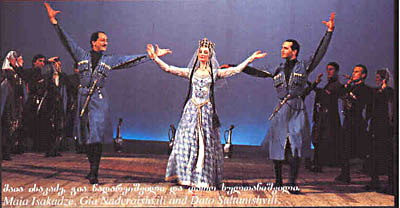
Nino with Tengiz Sukhishvili in Cincinnati. March 1998.
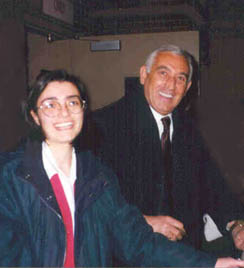
The images in this site have been taken from The Georgian National Ballet handbook.
Go Home
Designed and maintained by Nino Gigineishvili
Last Updated:07/07/98 10:09:05 PM